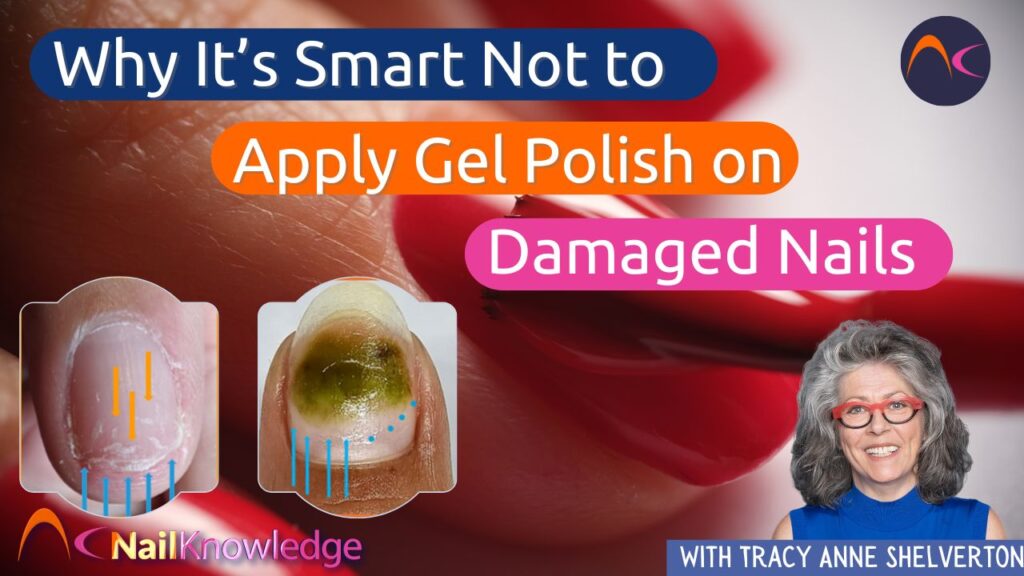Understanding the Risks of Reapplying Nail Coating Without Allowing Proper Recovery
When your nails are damaged, it’s essential to let the nail plate recover before reapplying any nail coating. Failing to do so can lead to complications, making it important to choose the best plan of action for nail health and appearance.
Visualizing the Impact: Before and After
Before: Normal nail coating after about 10 days, featuring one layer of a Builder Gel for shine and a bit of stability.

After: All Builder In A Bottle ripped off the nail plate along with the free edge of the nail plate.

The Importance of Sealing the Nail Plate
If we look at photo 2 and the yellow arrows, we need first to seal the upper layers of the nail plate before applying more Gel Polish, and if we cannot do that a more permanent base coat will need to be applied, if we don’t do this we will create pockets for air, moisture or both under our gel polish
- Air – causes lifting

These pockets can trap various contaminants your nails come into contact with, such as dirt, bacteria, and moisture. If caught early, the product can be removed and replaced to prevent issues. However, if not addressed, trapped moisture can create an ideal breeding ground for opportunistic pathogens like Pseudomonas aeruginosa, leading to potential infections.

What can we do to Prevent Problems Happening?
Accidents happen, we can’t prevent those but our clients can help with good maintenance of their nail enhancements. A good quality oil helps prevent a build up of moisture and also helps to keep your nail and nail coating flexible and less prone to breaking or cracking, so a win win for your client but also for your salon, longer lasting gorgeous nails and happier clients.
Can we Recover the Nail Plate?
We can, there is a special product on the market today that is available the world over, treatments such as this will re seal the upper layers of the nail plate from the inside out and you will be able to re-apply your artificial nail product without a problem.
Without this product its smart to prep your nail plate with a good nail plate cleanser, and apply a semi-permanent nail product such as acrylic Liquid & Powder – Acryl has more than one advantage over a hard gel or an acrygel, it is designed to remain on a nail plate for longer periods of time and that’s important to know with this kind of nail plate damage, but if necessary, it can also be safely removed by thinning with a nail file and soaking off the last layer for optimal control and no extra damage to the nail plate.
Risks of Applying Short-Life Nail Enhancements on Damaged Nails
Placing a ‘short life‘ nail enhancement on a damaged nail plate is asking for problems and complications – something we would like to avoid in the nail salon. Doing so can create pocket lifting or a great home for opportunistic pathogens that are hanging around waiting to do their thing, recovery of the nail plate after such an infection takes considerably longer than recovering the original damage of the nail coating being ripped off.
It’s a good idea to inform your salon clients about the pros and cons of nail plate and nail unit maintenance with oils and lotions, its not just a sales pitch, your clients are paying you good money for nail coatings – having spent that money they also have a responsibility to keep them in the best possible condition and your responsibility is to provide a safe lasting service with minimal chance of causing infections.
| Do | Don’t | Nail Product | Refer to MD |
| Keep clean and make smart choices | Disguise with artificial nail products without a plan | IBX, Oil & Lotion | If the nail becomes infected or changes colour |
| Use a semi-permanent product to aid recovery | Use hard gel or an acrygel – removal is difficult | Acryl -L&P | |
| Oil 4dd’s | High quality Oil & Lotion |
Contra indication: If the client already shows signs of a possible infection, redness, swelling or any changes in color do not reapply ANY artificial nail product. Refer to hygiene guidelines, hand care specialist or contact a MD


